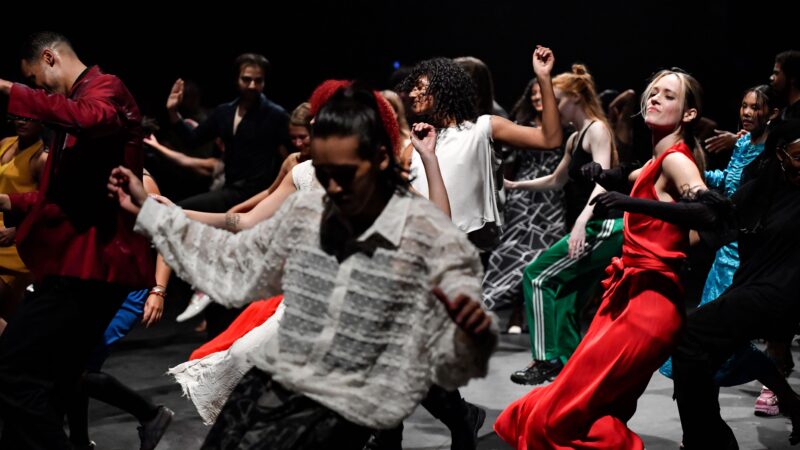New English Ballet Theatre, Aud Jebsen Studio Theatre, Royal; Academy of Dance
Clouds of Chanel perfume, clacking pearls, with plenty of room to swing a…..arabesque. Welcome to the gleaming columns of the Royal Academy of Dance. Admits this polite cacophony New English Ballet Theatre marks both Remembrance Day and simultaneously celebrates 12 years of existence.
Peeking in at dance lessons in the rooms surrounding the school’s theatre my heart longs for a future lost to the mists of time, my own short-lived balletic career. Fittingly it’s NEBT’s second time in the Aud Jebsen Studio Theatre, considering their year-round charity work nurturing young dancers, choreographers, musicians, and designers. The potent whiff of scholastic rigor makes up for the simplicity of the large black box theatre.
Four pieces are arranged around the ideas of loss and love and fluctuate greatly in their effectiveness and relevance to the war dead of the last 102 years. What doesn’t fluctuate is the dedication of all involved. Rare is it for classical ballet to be so close. Being able to hear the exertion, and almost reaching out to touch the dancers brings a reality to this dreamy genre.
Jenna Lee’s abstract and thematically diverse take on Antonio Vivaldi’s Four Seasons closes the evening and is by far the highlight. Finishing on renewal, rotation and regrowth is the optimistic note we all need as the current European war rages.
April Dalton’s costumes are playful in their interpretation of each season, clothing the characteristic choreography of Lee. The expected net and flowers flutter with the light hopefulness of spring. Shifting into a rather raunchy spandex summer affair that wouldn’t be out of place in a trip to Torture Garden (if you don’t know don’t google). Autumns brown leaves have kick and bounce as they fall gracefully to the floor, a touch mournfully morphing into winter’s icy frosting of lace, leg work, lifts, and cold hard precision (although giving us a little too much Disney’s Frozen). Andrew Ellis’s lights do their best with the polished black stage and both work hard to transport us out of Battersea.
Dylan Springer and Natalia Kerner in particular give hedonistic flair, sass, and sparkle and stand out in the solstitial section. Peppered throughout with dextrous Pas de deux all involved corporally inhabit each season, highlighting dance’s penchant for physicalising the nebulous.
Nocturne is at the other end of the evening with Genevieve Heron and Aitor Viscarolasaga Lopez in a subtle Pas de deux. Both in hues of blues, Daniela Cardim’s choreography asks for a constant falling and gathering, from floorwork to soft lifts. Like weeping willow trees, they billow up again, collapsing into each other’s arms, fingers dipped into the black waters of the floor. A touching sentiment to commitment and connection.
Following this is the most obviously themed work, an extract from Wayne Eagling’s ballet Remembrance. To George Frideric Handel’s Ode for St Cecilia’s Day, the aim of the piece is valiant. Focusing on the life of dancer Marie Rambert, during her marriage to Ashley Duke during the armistice year (1918).
There is a reason that music, instead of movement normally dominates the Remembrance programs. Dance’s strength lies more in the experimental, ephemeral exploration of ideas. With that in mind, this piece is uncomfortably melodramatic, with pantomime faces of mourning, and overtly literal projections onto the back wall. Thematic stumbles ensue when choreography is asked to craft such a clear narrative, requiring more intricacy than is available.
Re(current) is next, choreographed by Matthew Ball, a Pas de deux with himself and fellow Royal Ballet Principal dancer Mayara Magri. Magnificently executed by the seasoned professionals this is a treat. Topless and with flowing Japanese-style trousers Ball lifts Magri easily like a bag of feathers. They flux in and out of separate spots, using the barrenness of the stage to their advantage. Layering around one another, but always at angles, the building of Jean Sibelius’s Laetare Anima Mea pulls them both into a shared spot. Winding their bodies into wreathed patterns of extremities, Ball is a choreographer with a sharp mind. Despite its sober note, the visual sensuality of the work feels like an odd choice, following Eagling’s War Women Waiting.
NEBT exhibits an evening of new talent and established ability within dance. Covering a tough subject such as war on top of that proves to be over-ambitious. However, to see students in the classrooms, and the young and hopeful cavorting across the stage is its own statement. A statement of belief in the future, of the importance of art, community, and togetherness. A lasting memory that at its core couldn’t be a more fitting remembrance.
See what is on next from this ambitious company, click here!



